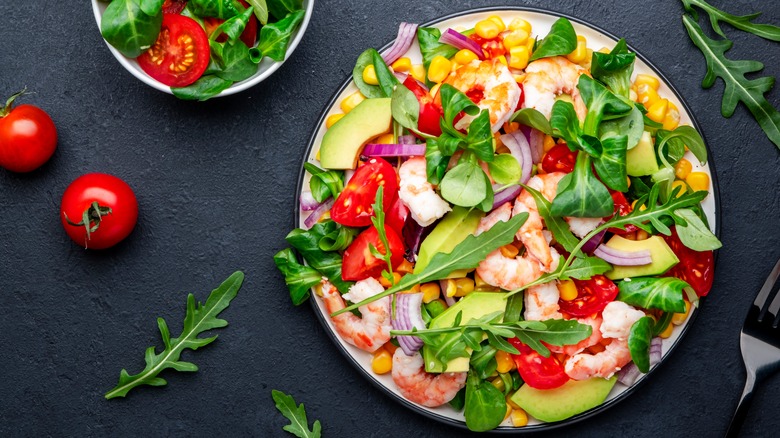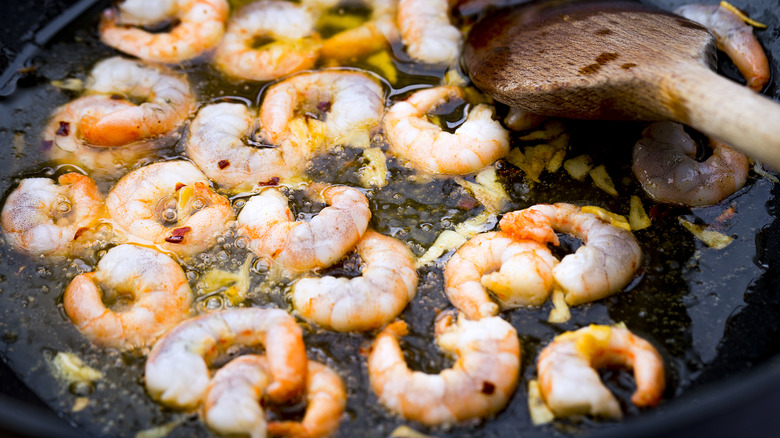Leftover Shrimp Is Begging To Be Repurposed Into Salad
Leftover food often goes from sitting in the fridge straight onto the stove or into the microwave for a quick reheat. This method works just fine most of the time, but why stop there and settle for an uninspiring meal when you can repurpose it into new dishes instead? With leftover shrimp, in particular, the latter is undoubtedly a better option, and it starts with a simple bowl of salad. No matter what you had for dinner last night, as long as there's leftover shrimp, a fresh yet flavorful and protein-packed salad is an easy feature on the menu the next day.
Already peeled, seasoned, and cooked, leftover shrimp offers the great convenience of skipping a multi-step preparation process when you're putting together a salad. All it requires is a quick reheat. You can even skip that part altogether in certain cases. More than just a quick shortcut, this is also a budget-friendly way to fully utilize your unfinished food and not let anything go to waste.
The shrimp salad potential is endless
There are plenty of ways to use shrimp in salads, and it's no different with leftover shrimp. For starters, we have the classic shrimp salad, which mostly uses boiled shrimp, but baked and other cooking methods work as well. The vegetables are usually of crunchy varieties, such as potato, carrot, celery, onion, bell pepper, etc. That said, feel free to chuck in anything else you like. The dressing is a creamy, tangy mixture of mayonnaise and lemon juice, plus salt, pepper, chopped herbs, and perhaps mustard if you want a more pronounced peppery kick.
Depending on the flavor profile of your leftover shrimp, you can also get creative with other types of salad. Spicy and bold ones would fare well in a Mexican salad loaded with corn, avocado, and jalapeño peppers, a Chipotle shrimp salad and its smoky adobo sauce, or pla goong — a Thai specialty featuring herbs, chiles, and a vibrant fish-sauce-based dressing. On the milder side, you might find it a pleasant addition to a Japanese cucumber salad called sunomono, or just a typical summer salad with fresh basil and colorful tomatoes. If your shrimp came straight from pasta dishes, a pasta salad would be a fitting follow-up, and you can even make use of the leftover sauce as well.
When should you reheat the leftover shrimp?
Whether your leftover shrimp needs reheating or not depends mostly on how it was cooked (and unsurprisingly, there are many ways to cook it perfectly). Plain, boiled shrimp can be enjoyed cold or at room temperature, just make sure it isn't mushy, slimy, or has a terrible odor. However, you can also reheat it by putting it into a bowl with a small splash of water, cover it with plastic wrap, and then microwave for 30 seconds or until heated. This is a quick and easy way to reheat shrimp without drying it out.
If your shrimp was baked, fried, or prepared in ways that involve heavy seasonings, a reheat is worth considering. This will not only help to bring back some of the original flavors but also smooth out the overall texture and give it a bit of moisture. For sautéed, grilled, or roasted shrimp, you can give it a quick stir on the stovetop with olive oil or butter for 2 to 3 minutes. Another way is to steam the shrimp, which is especially great for preserving flavors and ensuring tenderness. Got some crispy shrimp? Into the air-fryer basket it goes if you want to revive as much of the original texture as possible. No matter which approach you choose, bear in mind that shrimp overcook quickly, so keep the cooking temperature on the lower end and only reheat for around 5 or 6 minutes.


